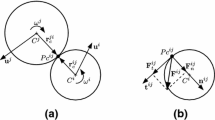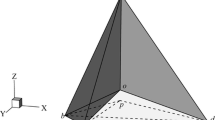Abstract
We present an extended particle model for the discrete element method that on the one hand is tetrahedral in shape and on the other hand is capable to describe deformations. The deformations of the tetrahedral particles require a framework to interrelate the particle strains and resulting stresses. Hence, adaptations from the finite element method were used. This allows to link the two methods and to adequately describe material and simulation parameters separately in each scope. Due to the complexity arising of the non-spherical tetrahedral geometry, all possible contact combinations of vertices, edges, and surfaces must be considered by the used contact detection algorithm. The deformations of the particles make the contact evaluation even more challenging. Therefore, a robust contact detection algorithm based on an optimization approach that exploits temporal coherence is presented. This algorithm is suitable for general \(\mathbb {R}^{\text {n}}\) simplices. An evaluation of the robustness of this algorithm is performed using a numerical example. In order to create complex geometries, bonds between these deformable particles are introduced. This coupling via the tetrahedra faces allows the simulation bonding of deformable bodies composed of several particles. Numerical examples are presented and validated with results that are obtained by the same simulation setup modeled with the finite element method. The intention of using these bonds is to be able to model fracture and material failure. Therefore, the bonds between the particles are not lasting and feature a release mechanism based on a predefined criterion.















Similar content being viewed by others
References
Abaqus (2014) ABAQUS Documentation. Dassault Systèmes, USA
Alonso-Marroquín F, Wang Y (2009) An efficient algorithm for granular dynamics simulations with complex-shaped objects. Granul Matter 11(5):317–329
Bagherzadeh KhA, Mirghasemi A, Mohammadi S (2011) Numerical simulation of particle breakage of angular particles using combined DEM and FEM. Powder Technol 205(1–3):15–29
Bathe KJ (1996) Finite element procedures. Prentice Hall, New Jersey
Boon CW, Houlsby GT, Utili S (2012) A new algorithm for contact detection between convex polygonal and polyhedral particles in the discrete element method. Comput Geotech 44:73–82
Boon CW, Houlsby GT, Utili S (2013) A new contact detection algorithm for three-dimensional non-spherical particles. Powder Technol 248:94–102
Cleary PW (2010) DEM prediction of industrial and geophysical particle flows. Particuology 8(2):106–118
Cundall PA (1988) Formulation of a three-dimensional distinct element model—Part I. A scheme to detect and represent contacts in a system composed of many polyhedral blocks. Int J Rock Mech Min Sci Geomech Abstr 25(3):107–116
Ergenzinger C, Seifried R, Eberhard P (2011) A discrete element model to describe failure of strong rock in uniaxial compression. Granul Matter 13(4):341–364
Favier JF, Abbaspour-Fard M, Kremmer M, Raji AO (1999) Shape representation of axi-symmetrical, non-spherical particles in discrete element simulation using multi-element model particles. Eng Comput 16(4):467–480
Fleissner F (2010) Parallel object oriented simulation with Lagrangian particle methods. Doctoral thesis, Schriften aus dem Institut für Technische und Numerische Mechanik der Universität Stuttgart, vol 16. Shaker Verlag, Aachen
Gethin DT, Lewis RW, Ransing RS (2003) A discrete deformable element approach for the compaction of powder systems. Model Simul Mater Sci Eng 11:101–114
Höhner D, Wirtz S, Kruggel-Emden H, Scherer V (2011) Comparison of the multi-sphere and polyhedral approach to simulate non-spherical particles within the discrete element method: Influence on temporal force evolution for multiple contacts. Powder Technol 208(3):643–656
Houlsby GT (2009) Potential particles: a method for modelling non-circular particles in DEM. Comput Geotech 36(6):953–959
Jensen RP, Bosscher PJ, Plesha ME, Edil TB (1999) DEM simulation of granular media-structure interface: effects of surface roughness and particle shape. Int J Numer Anal Methods in Geomech 23(6):531–547
Lu M, McDowell GR (2007) The importance of modelling ballast particle shape in the discrete element method. Granul Matter 9(1):69–80
Markauskas D, Kačianauskas R, Džiugys A, Navakas R (2010) Investigation of adequacy of multi-sphere approximation of elliptical particles for DEM simulations. Granul Matter 12(1):107–123
Mas Ivars D, Potyondy DO, Pierce M, Cundall PA (2008) The smooth-joint contact model. In: Joint Conference 8th. World Congress on computational mechanics (WCCM8) and 5th. European Congress on computational methods in applied sciences and engineering (ECCOMAS 2008)
Munjiza A (2004) The combined finite-discrete element method. Wiley, Chichester
Nezami EG, Hashash YMA, Zhao D, Ghaboussi J (2004) A fast contact detection algorithm for 3-d discrete element method. Comput Geotech 31(7):575–587
Nezami EG, Hashash YMA, Zhao D, Ghaboussi J (2006) Shortest link method for contact detection in discrete element method. Int J Numer Anal Methods Geomech 30:783–801
Obermayr M, Dressler K, Vrettos C, Eberhard P (2013) A bonded-particle model for cemented sand. Comput Geotech 49:299–313
Pournin L, Liebling TM (2005) A generalization of distinct element method to tridimensional particles with complex shapes. In: García-Rojo R, Herrmann H, McNamara S (eds) Powders and grains 2005. A.A. Balkema Publishers, Rotterdam, pp 1375–1378
Rémond S, Gallias JL, Mizrahi A (2008) Simulation of the packing of granular mixtures of non-convex particles and voids characterization. Granul Matter 10(3):157–170
Shabana AA (2013) Dynamics of multibody systems, 4th edn. Cambridge University Press, New York
Stühler S, Fleissner F, Seifried R, Eberhard P (2013) A discrete element approach for wave propagation in thin rods. PAMM 13(1):31–32
Tonon F (2004) Explicit exact formulas for the 3-d tetrahedron inertia tensor in terms of its vertex coordinates. J Math Stat 1(1):8–11
Wellmann C, Lillie C, Wriggers P (2008) A contact detection algorithm for superellipsoids based on the common-normal concept. Eng Comput 25(5):432–442
Williams JR, Pentland AP (1992) Superquadrics and modal dynamics for discrete elements in interactive design. Eng Comput 9(2):115–127
Zienkiewicz OC, Taylor RL, Fox DD (2013) The finite element method for solid and structural mechanics, 7th edn. Butterworth-Heinemann, Oxford
Author information
Authors and Affiliations
Corresponding author
Ethics declarations
Conflicts of interest
The authors declare that they have no conflict of interest.
Rights and permissions
About this article
Cite this article
Stühler, S., Fleissner, F. & Eberhard, P. A contact detection algorithm for deformable tetrahedral geometries based on a novel approach for general simplices used in the discrete element method. Comp. Part. Mech. 5, 35–47 (2018). https://doi.org/10.1007/s40571-016-0147-y
Received:
Revised:
Accepted:
Published:
Issue Date:
DOI: https://doi.org/10.1007/s40571-016-0147-y




